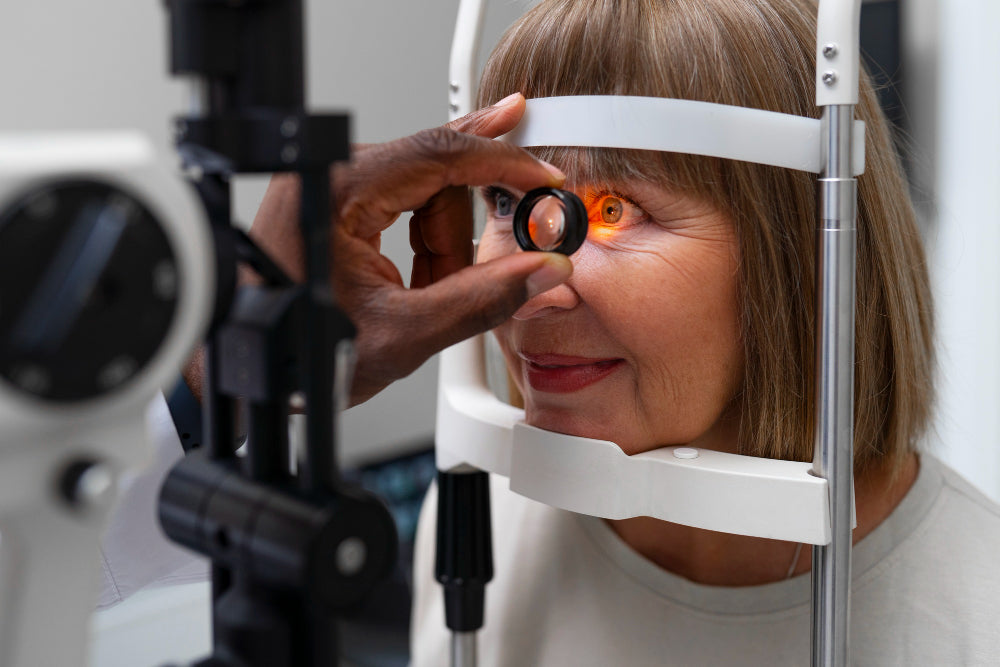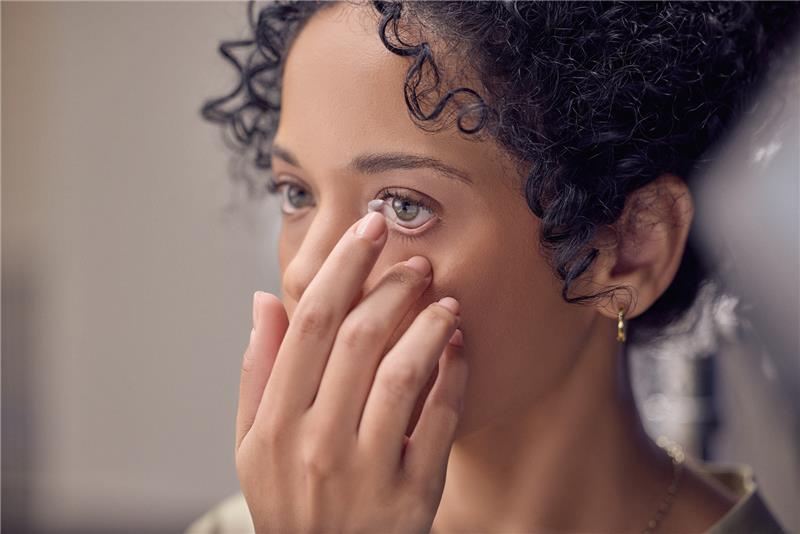Eye problems and headaches are often interconnected, shedding light on the critical relationship between vision health and overall well-being. Understanding how eye issues can lead to headaches is vital for maintaining optimal health and quality of life.
Can eye problems cause headaches? Yes, eye problems such as strain, dryness, or uncorrected refractive error can lead to headaches due to increased stress on the eyes and related muscles, often resulting in tension headaches or migraines.
Regular eye check-ups and proper vision correction can help alleviate such issues. Let's delve into the intricate connection between eye problems and headaches, exploring the impact of conditions like eye strain, bad eyesight, and other vision-related issues on our daily lives.
The Link Between Vision Problems and Headaches
Eye strain can cause headaches. We'll find out about the link between the two below.
Eye Strain and Headaches
Prolonged screen time, reading in poor lighting, or focusing intensely for extended periods can lead to eye strain. This strain on the eyes can trigger headaches, often called tension headaches, due to the overworked eye muscles.
Vision Issues and Headaches
Uncorrected vision problems like farsightedness or presbyopia can result in eye strain, leading to headaches as the eyes struggle to focus properly on nearby objects. This can cause discomfort and headaches as the eyes work harder to compensate for the vision impairment.
Eye Health and Dizziness
Poor eye health can also manifest as dizziness, especially in cases where there are issues with eye muscle coordination or nerve function related to the eyes. Conditions like binocular vision dysfunction (BVD) can cause dizziness, vertigo, and headaches due to misalignment of the eyes.
Exploring the Impact of Eye Problems on Headaches

Recognizing the impact of conditions like eye strain, uncorrected vision issues, and poor eye health on headaches and dizziness, individuals can take proactive steps to address these concerns.
The following are the most common eye problems that cause headaches:
Migraines and Vision Changes
Migraine headaches can often be accompanied by visual disturbances, such as blurry vision, flashing lights, or temporary blindness. These vision-related disturbances are among the common headaches due to eye problem symptoms that individuals experience. Understanding the visual symptoms associated with migraines is crucial in managing these intense headaches effectively.
Ocular Migraines
Ocular migraines, a rare condition, can lead to repeated attacks of short-term blindness or blurred vision. These vision changes may coincide with migraines, highlighting the sensitive relationship between eye health and headaches.
Eye Strain
Overusing the eye muscles involved in vision focus can lead to eye strain, which can subsequently cause headaches. Activities like prolonged screen time or intense focus can contribute to eye strain and headaches.
Dehydration
Dehydration can exacerbate eye strain, leading to headaches, blurred vision, and fatigue. Maintaining proper hydration levels is essential in preventing the adverse effects of dehydration on eye health and headaches.
Astigmatism
Astigmatism, where the cornea is not shaped correctly, can interfere with vision and lead to headaches, often accompanied by symptoms like squinting.
Glaucoma
Glaucoma, which involves increased pressure in the eye, can cause headaches, often felt around the eyes or forehead. Symptoms may include bloodshot eyes, eye pain, blurred vision, and nausea/vomiting.
Cataracts
Cataracts, where the lens becomes clouded, can make the eye work harder to see, leading to eye strain and potentially headaches.
Diabetic Retinopathy
Unmanaged diabetes can damage the retina over time, which can also contribute to headaches.
Addressing Eye Problems for Better Headache Management

The key to better manage headaches is regular eye exams to identify and address any underlying vision issues causing recurring headaches.
Regular Eye Exams
The American Academy of Ophthalmology reinforces the importance of regular eye exams in identifying and addressing potential eye health issues that could contribute to headaches and dizziness.
Treatment for Eye Strain
Correcting misalignments between the eyes with specialized lenses can help alleviate symptoms of eye strain, dizziness, and headaches associated with conditions like BVD.
What are Some Exercises to Prevent Eye Strain and Headaches?
Here are some key ways to prevent eye strain and headaches:
- Follow the 20-20-20 rule. Every 20 minutes, you should look at something 20 feet away for 20 seconds. This helps relax the eye muscles.
- Blinking frequently while working on screens helps produce tears that moisten and refresh the eyes, preventing dryness and reducing eye strain.
- Adjust your screen settings such as brightness, contrast, color temperature, font size - to reduce glare and improve readability.
- Use proper lighting to avoid working in dark/dim rooms or with direct overhead lighting that can cause glare.
- Position your screen at an arm's length distance and slightly below eye level to maintain a comfortable posture.
- Do eye exercises like rolling your eyes or closing them tightly to relieve tension.
- Wear corrective lenses or computer glasses if needed, and consult an eye doctor regularly.
Just be proactive in addressing factors contributing to eye strain and headaches through simple adjustments to your work environment and habits. Consistent self-care for your eyes is crucial.
What are Some Natural Remedies to Prevent Eye Strain and Headaches?

Some natural remedies to prevent eye strain and headaches include:
- Eye Massage: Massaging the eyelids, muscles above the eyebrows, under-eyes, and temples can increase blood circulation, relax eye muscles, and stimulate tear glands to prevent dry eyes.
- Sunning: Allowing sunlight to warm your eyelids without glasses or contact lenses can help release dopamine in the retina, promoting healthy eye development and preventing myopia in children.
- Warm Compress: A gentle, warm compress on your eyelids after a long screen time can relax eye muscles and relieve dry eyes.
- Cold Water: Splashing cold water on your eyes can improve blood circulation, relax strained muscles, and reduce puffiness or swelling around the eyes.
- Improving Air Quality: Enhancing the air quality in your environment by using a ventilator humidifier and adjusting the thermostat can help ease eye strain and promote overall eye health.
- Maintaining a healthy lifestyle: Stay hydrated, sleep well, and manage stress.
- Taking regular breaks: Frequent breaks to get up, stretch, and move around to improve blood circulation.
These natural remedies, combined with short breaks, an active lifestyle, and a balanced diet, can contribute to healthy, strain-free eyes and reduce the likelihood of developing headaches associated with eye strain.
How Can Blue Light Glasses Help Prevent Eye Strain and Headaches?

Blue light glasses help prevent eye strain and headaches in the following ways:
- Filtering Blue Light: Blue light glasses filter out a portion of the high-energy blue light ejected from digital screens. This can help reduce the eye strain caused by prolonged exposure to blue light.
- Reducing Digital Eye Strain Symptoms: By blocking blue light, blue light glasses may help alleviate some of the typical annoying symptoms of digital eye strain, such as sore, tired, or dry eyes, as well as headaches.
- Improving Comfort During Screen Time: The reduced blue light exposure from wearing blue light glasses can make prolonged screen time more comfortable, potentially preventing the development of headaches.
- Potential Migraine Relief: While blue light does not directly cause migraines, research suggests it can exacerbate migraine pain and sensitivity. Wearing blue light glasses may help provide some relief for migraine sufferers.
The clinical evidence on the effectiveness of blue light glasses for preventing headaches is mixed. Some people have reported benefits, while others have not experienced a significant reduction in headaches.
Using blue light glasses combined with other preventative measures, such as following the 20-20-20 rule, adjusting screen settings, and taking regular breaks, addresses the underlying causes of eye strain and headaches.
Summing Up
In conclusion, vision problems can cause headaches, underscoring the importance of prioritizing vision health for overall well-being. Imagine the frustration of a constant throb behind your eyes, only to discover it's linked to a simple vision issue.
Regular eye exams, proper hydration, and targeted treatments for eye strain can significantly improve quality of life and reduce the burden of headaches caused by vision issues.Don't let eye problems steal your peace of mind.
By understanding this nuanced connection, you can empower yourself to take control of your vision health and mitigate the impact of these problems on your daily life. So, schedule our eye appointment today and experience the difference.
Delve Deeper:





